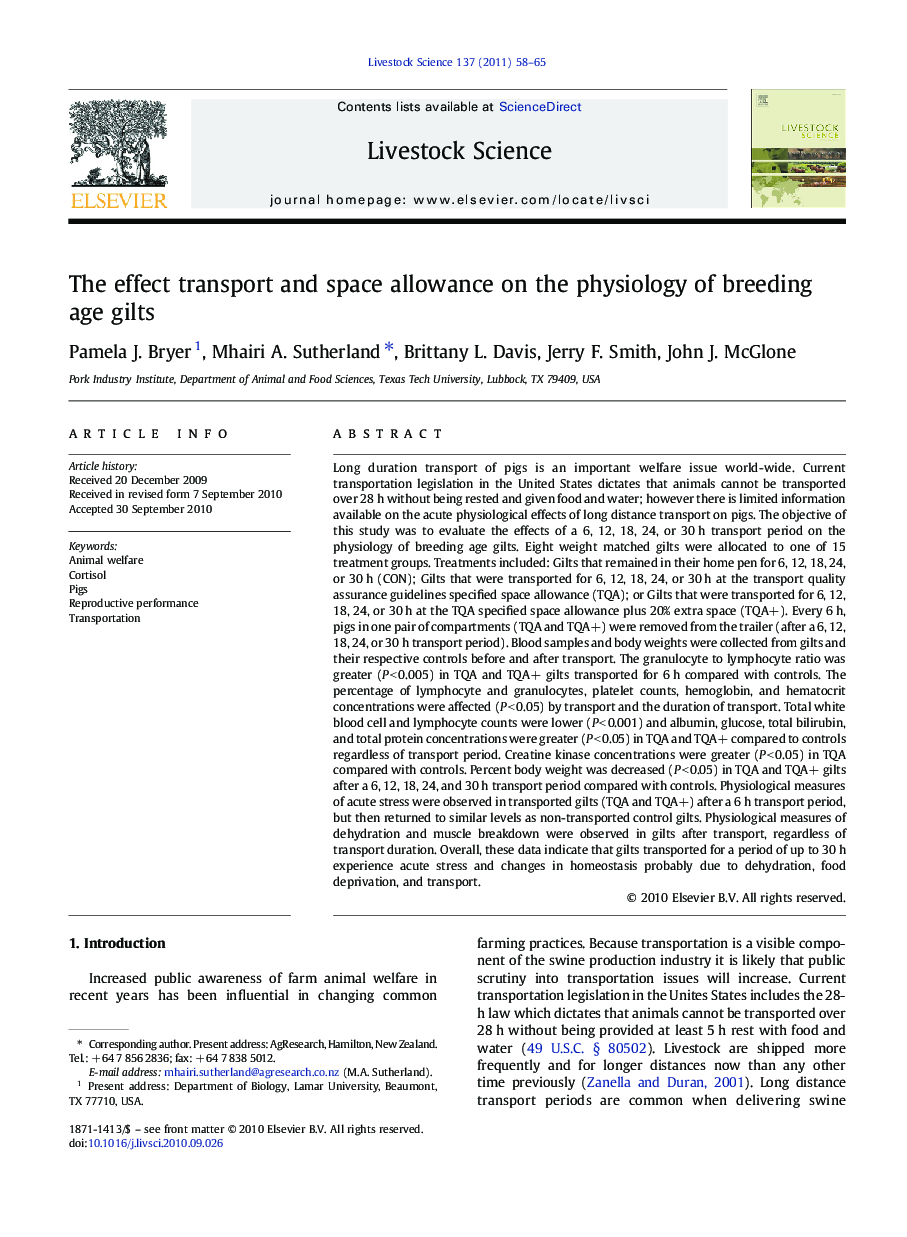| کد مقاله | کد نشریه | سال انتشار | مقاله انگلیسی | نسخه تمام متن |
|---|---|---|---|---|
| 5790957 | 1553995 | 2011 | 8 صفحه PDF | دانلود رایگان |
عنوان انگلیسی مقاله ISI
The effect transport and space allowance on the physiology of breeding age gilts
دانلود مقاله + سفارش ترجمه
دانلود مقاله ISI انگلیسی
رایگان برای ایرانیان
کلمات کلیدی
موضوعات مرتبط
علوم زیستی و بیوفناوری
علوم کشاورزی و بیولوژیک
علوم دامی و جانورشناسی
پیش نمایش صفحه اول مقاله

چکیده انگلیسی
Long duration transport of pigs is an important welfare issue world-wide. Current transportation legislation in the United States dictates that animals cannot be transported over 28Â h without being rested and given food and water; however there is limited information available on the acute physiological effects of long distance transport on pigs. The objective of this study was to evaluate the effects of a 6, 12, 18, 24, or 30Â h transport period on the physiology of breeding age gilts. Eight weight matched gilts were allocated to one of 15 treatment groups. Treatments included: Gilts that remained in their home pen for 6, 12, 18, 24, or 30Â h (CON); Gilts that were transported for 6, 12, 18, 24, or 30Â h at the transport quality assurance guidelines specified space allowance (TQA); or Gilts that were transported for 6, 12, 18, 24, or 30Â h at the TQA specified space allowance plus 20% extra space (TQA+). Every 6Â h, pigs in one pair of compartments (TQA and TQA+) were removed from the trailer (after a 6, 12, 18, 24, or 30Â h transport period). Blood samples and body weights were collected from gilts and their respective controls before and after transport. The granulocyte to lymphocyte ratio was greater (PÂ <Â 0.005) in TQA and TQA+ gilts transported for 6Â h compared with controls. The percentage of lymphocyte and granulocytes, platelet counts, hemoglobin, and hematocrit concentrations were affected (PÂ <Â 0.05) by transport and the duration of transport. Total white blood cell and lymphocyte counts were lower (PÂ <Â 0.001) and albumin, glucose, total bilirubin, and total protein concentrations were greater (PÂ <Â 0.05) in TQA and TQA+ compared to controls regardless of transport period. Creatine kinase concentrations were greater (PÂ <Â 0.05) in TQA compared with controls. Percent body weight was decreased (PÂ <Â 0.05) in TQA and TQA+ gilts after a 6, 12, 18, 24, and 30Â h transport period compared with controls. Physiological measures of acute stress were observed in transported gilts (TQA and TQA+) after a 6Â h transport period, but then returned to similar levels as non-transported control gilts. Physiological measures of dehydration and muscle breakdown were observed in gilts after transport, regardless of transport duration. Overall, these data indicate that gilts transported for a period of up to 30Â h experience acute stress and changes in homeostasis probably due to dehydration, food deprivation, and transport.
ناشر
Database: Elsevier - ScienceDirect (ساینس دایرکت)
Journal: Livestock Science - Volume 137, Issues 1â3, May 2011, Pages 58-65
Journal: Livestock Science - Volume 137, Issues 1â3, May 2011, Pages 58-65
نویسندگان
Pamela J. Bryer, Mhairi A. Sutherland, Brittany L. Davis, Jerry F. Smith, John J. McGlone,